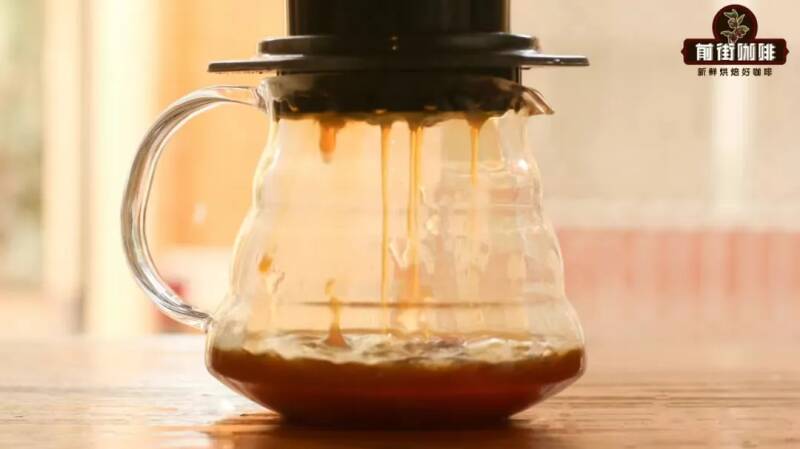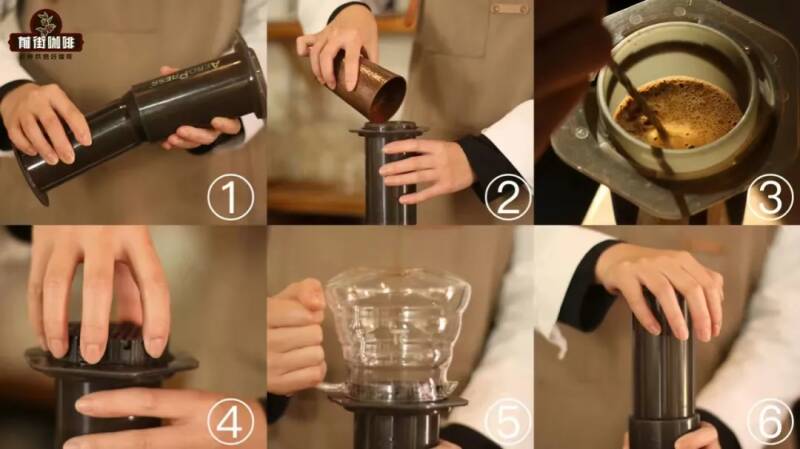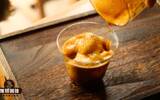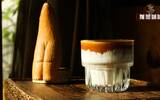What are the characteristics of the Aiyue pressed coffee pot? How fine is the grinding of Aiyue Press? What is the operating process of Aiyue Pressure?
Aeropress, a coffee extraction device made by inventors who dislike the trouble of brewing. The way to use it is very simple, just put in the powder and hot water after the accessories are assembled, and finally press the coffee out.
Compared with the traditional coffee extraction, it can be said that the game of Ailo pressure is very rich. You can either make coffee according to the officially recommended positive pressure extraction method, or you can be a maverick, turning the barrel upside down and making coffee in the form of reverse pressure. With different grinding, water temperature, powder-water ratio, mixing time, pressing strength and so on, we can create a lot of extraction formulas. Due to the diversity of ways of playing, the official also holds a special Philharmonic pressure event every year, so that players can show their strength in the competition!
But we soon found that although the officially recommended Philharmonic pressure extraction method is "positive pressure", but the vast majority of enthusiasts prefer to use "reverse pressure" for coffee extraction, why?
You might as well share from the front street why Philharmonic fans prefer to use reverse pressure for coffee extraction. Before that, let's first understand what is positive pressure and what is reverse pressure.
What is positive pressure / back pressure? The Philharmonic pressure extraction is very interesting, first of all, soak the hot water into full contact with the coffee powder, then add stirring to enhance the dissolution rate of the flavor substances in the coffee powder, and finally press the coffee liquid out with pressure! Such a process ensures that we can extract a pot of delicious and fragrant coffee in the shortest possible time with the least amount of operation.

The so-called positive pressure means that the pot body of the Philharmonic pressure is being soaked and extracted on the cup, that is, the direction of the strainer facing down. This will require the first assembly of the filter, and then squeeze the pressure into the coffee liquid; reverse pressure is to assemble the cylinder, and then buckle it upside down to soak the coffee at the bottom. When the soaking is finished, install the strainer and buckle the cup, and then the kickback comes over for pressing and extraction, which is the operation flow of the following figure.

It seems that the steps are roughly the same, and the reverse pressure is one more inverted behavior than the positive pressure in the process of extraction. So why is the use of reverse pressure far more than the officially recommended positive pressure? Why don't we do an experiment on Qianjie to let everyone understand this intuitively? The coffee beans used in this experiment are "Chaka of Rose Xia Village Manor".
Rosa Village Manor was founded by documentary filmmaker Adam Overton and his wife, Rachel Samuel, who works as a photographer. At first, they became attached to coffee because they filmed a local Ethiopian coffee documentary, and came up with the idea of setting up an estate to produce coffee in Ethiopia. In 2009, they came into contact with the owners of Deborah Manor and Arida Manor, which deepened their obsession with the creation of the manor. So in 2011, the couple returned to Ethiopia to collect bean seeds from the place where Banchi Maggie found Rosa, and took them back to the village of Rosa to set up an estate for cultivation, completely embarking on the production of coffee.
Chaka is the most cost-effective coffee bean produced by Rosa Village Manor. It is a mixture of different coffee varieties from all the plots in Rosa Village, including Rosa 1931, Gori Rosa, and native varieties from Ethiopia.
Because the flavor is excellent and the price is not high, the heat of Chaka remains high recently, which is very popular. After the introduction, then the front street will use Chaka to test the difference between the positive pressure and the back pressure of the Philharmonic pressure.
What is the difference between the positive and negative pressure of the Philharmonic pressure? The parameters used in this experiment are all the same, and the only difference is the extraction mode. The parameters are as follows: the amount of powder is 18g, the ratio of powder to water is 1:11, the degree of grinding is 9 degrees of ek43 and the water temperature is 92 °C. (then because there is a process diagram above, it will not be released here.) first of all, we assemble the corresponding components according to different extraction methods. The positive pressure needs to install the filter paper and the filter screen on the kettle body, and then the filter screen is facing down, and the Philharmonic pressure is placed on the pressure-resistant cup, while the reverse pressure is to assemble the pressure cylinder on the cylinder body, buckle it upside down, and press the cylinder down.
Following the same extraction steps, we put in the coffee powder and steam it with twice the amount of water for 30 seconds. When the steaming is over, directly inject all the remaining target water 190ml, then take out the mixing stick and stir 5 times clockwise, soak to 1 minute and 30 seconds and you can prepare the coffee to be hydraulically squeezed out!
The positive pressure extraction can be directly loaded with a pressure cylinder for pressure, while the reverse pressure needs to be fitted with a filter paper filter, buckle the cup, and then buckle upside down before the pressure can be applied. In the process of exerting pressure, we must remember not to be too hasty, but to press down with a slow and uniform force.
Extraction is over! The total extraction time of positive pressure is 1 minute 35 seconds, and that of reverse pressure is 1 minute 42 seconds. In terms of taste, there is indeed some difference between the two. Chaka with reverse pressure extraction shows sweet and sour flavors of citrus and berries, light white flowers, and a fresh green tea tail, which will be more mellow than those washed out by hands because of the presence of a little powder. And the positive pressure Chaka is a little thin in comparison, not only that, the flavor performance is also a little inferior, sour.
The main reason for this difference is that part of the hot water extracted by positive pressure will seep out from the gap, and not all hot water will cause sufficient extraction of coffee powder, so this leads to, compared with reverse pressure extraction, the taste of positive pressure is thinner and the flavor is less prominent.
To sum up, the answer is obvious. The reason why many friends prefer reverse pressure when using Philharmonic pressure is that it is more stable and more friendly to beginners. But in fact, as long as we can find a suitable extraction parameter, then the positive pressure production of Philharmonic pressure coffee will also have a very good performance. For example, after the grinding in Qianjie, although the taste is not as thick as the reverse pressure, its flavor will be more prominent and the sense of hierarchy will be richer.
-END-
Front Street Cafe
No. 10 Baoqian street, Yandun road, Dongshankou, Yuexiu district, Guangzhou, Guangdong province
Important Notice :
前街咖啡 FrontStreet Coffee has moved to new addredd:
FrontStreet Coffee Address: 315,Donghua East Road,GuangZhou
Tel:020 38364473
- Prev

What are the characteristics of espresso? What are espresso? How to make unpopular espresso coffee with milk? What is red-eye coffee?
Espresso is a very large "coffee family." A small serving of espresso can be transformed into a completely different product by adding different ingredients. Not only that, take milk coffee as an example, with more milk, less milk, thinner and thicker milk foam, these different combinations can also be combined to create a coffee with
- Next

Why is dirty coffee so popular? What is the difference between dirty coffee and iced latte? What does Dirty do? What does Dirty mean?
Dirty, we are accustomed to calling it dirty coffee, but of course some people will use transliteration to call it "decent." In terms of the combination of materials, dirty coffee is actually a small cup of iced latte without ice. Many people thought that dirty coffee was a flash in the pan at the beginning, but they never thought that even
Related
- What effect does Italian American coffee with filter paper have? Will coffee taste better if it is put on filter paper at the bottom of the powder bowl?
- What is the color difference in coffee beans? What are the characteristics of honey processed coffee beans? Why are the anaerobically treated coffee beans uneven in color?
- How does novice Xiaobai quickly get started and make coffee? Newbies learn to make coffee by hand and share the specific steps and process process!
- Costa tea has a shelf life of 100 years?! Expert: Unable to verify
- It's a huge uproar! American milk addition was rejected by Manner employees?!
- Mocha pot coffee bean recommendations| How fine and how much powder should be used for grinding? What parameter ratios do I need to use to make milk with Mocha pot coffee?
- What are the characteristics of the world's top ten coffee beans treated with Costa Rica honey? How to make black honey kadura from Tarazhu Pilon Processing Plant taste good?
- How to make deep-roasted coffee? What grinding water temperature does authentic Jamaica Blue Mountain No. 1 coffee use to brew it well?
- Selected high-grade rose summer coffee flavor tasting guide Why Panama rose summer has the aroma of flowers and fruits
- What equipment does a novice Xiaobai need to buy to learn to make coffee? Filter cup electronic scale bean grinder manual flushing pot purchase guide

